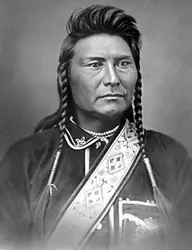Chief Joseph
 Chief Joseph of the Nez Perce was one of the most noble leaders in Native American history. His given tribal name was Hin-mah-too-yah-lat-kekt, or Thunder Rolling Down the Mountain. But he was widely known as Joseph, which was also his father’s name. He was born in Oregon in 1840.
Chief Joseph of the Nez Perce was one of the most noble leaders in Native American history. His given tribal name was Hin-mah-too-yah-lat-kekt, or Thunder Rolling Down the Mountain. But he was widely known as Joseph, which was also his father’s name. He was born in Oregon in 1840.

The older Chief Joseph was one of the first Nez Perce to convert to Christianity. For many years, he had peaceful relations with whites. The US government took six million acres of Nez Perce land in 1863 after gold was discovered there, and that made the older Joseph very angry. He was so angry, in fact, that he destroyed his Bible and went back to the ancient ways of the Nez Perce. As an old man, he told his son “This country holds your father’s body. Never sell the bones of your father and mother.”

After the death of his father, the younger Joseph became chief. He wanted to keep peace with whites, but was determined not to give up Nez Perce land. By the time he became chief, even more white settlers were moving into the Wallowa Valley, which was home to the Nez Perce. The US government told the Nez Perce that they could stay on their land and that white people would be removed, but they soon changed their mind. Chief Joseph decided sadly to move his people toward Idaho.

Along the way, a small band of Nez Perce warriors decided to raid nearby white settlements because they were angry at the loss of their homes. They killed several white people, and the army quickly pursued them. Even though he had always wanted peace, Chief Joseph felt he had no choice but to fight with his people.

Over the next three months, a band of about 700 Nez Perce (most of whom were not warriors) fought over twice that many American soldiers. With no other choice, Chief Joseph surrendered on October 5, 1877. The speech he gave at his surrender is one of the most famous speeches in American history:

“I am tired of fighting. Our chiefs are killed. Looking Glass is dead. Toohoolhoolzote is dead. The old men are all dead. It is the young men who say, “Yes” or “No.” he who led the young men is dead. It is cold, and we have no blankets. The little children are freezing to death. My people, some of them, have run away to the hills, and have no blankets, no food. No one knows where they are—perhaps freezing to death. I want to have time to look for my children, and see how many of them I can find. Maybe I shall find them among the dead. Hear me, my chiefs! I am tired. My heart is sick and sad. From where the sun now stands I will fight no more forever.”

He was promised that he would be allowed to return to his home, but was held on reservations for several years. He and other Nez Perce finally returned in 1885. When Chief Joseph died in 1904, it was said to be from a broken heart.
Facts About Chief Joseph:
- Chief Joseph’s grave is marked by the statues of two Native Americans standing guard
- In 1879, Chief Joseph met President Rutherford B. Hayes to plead his case



